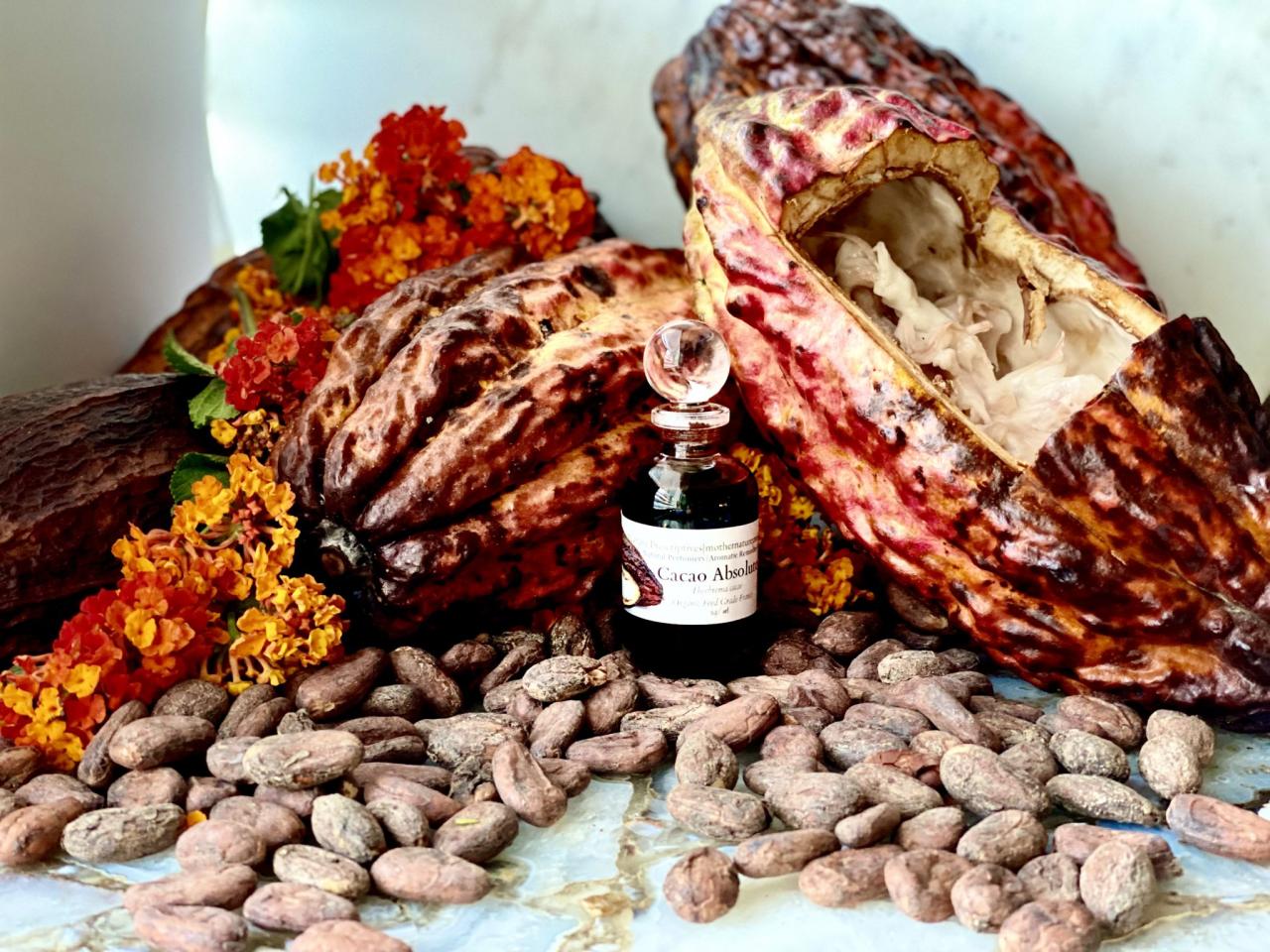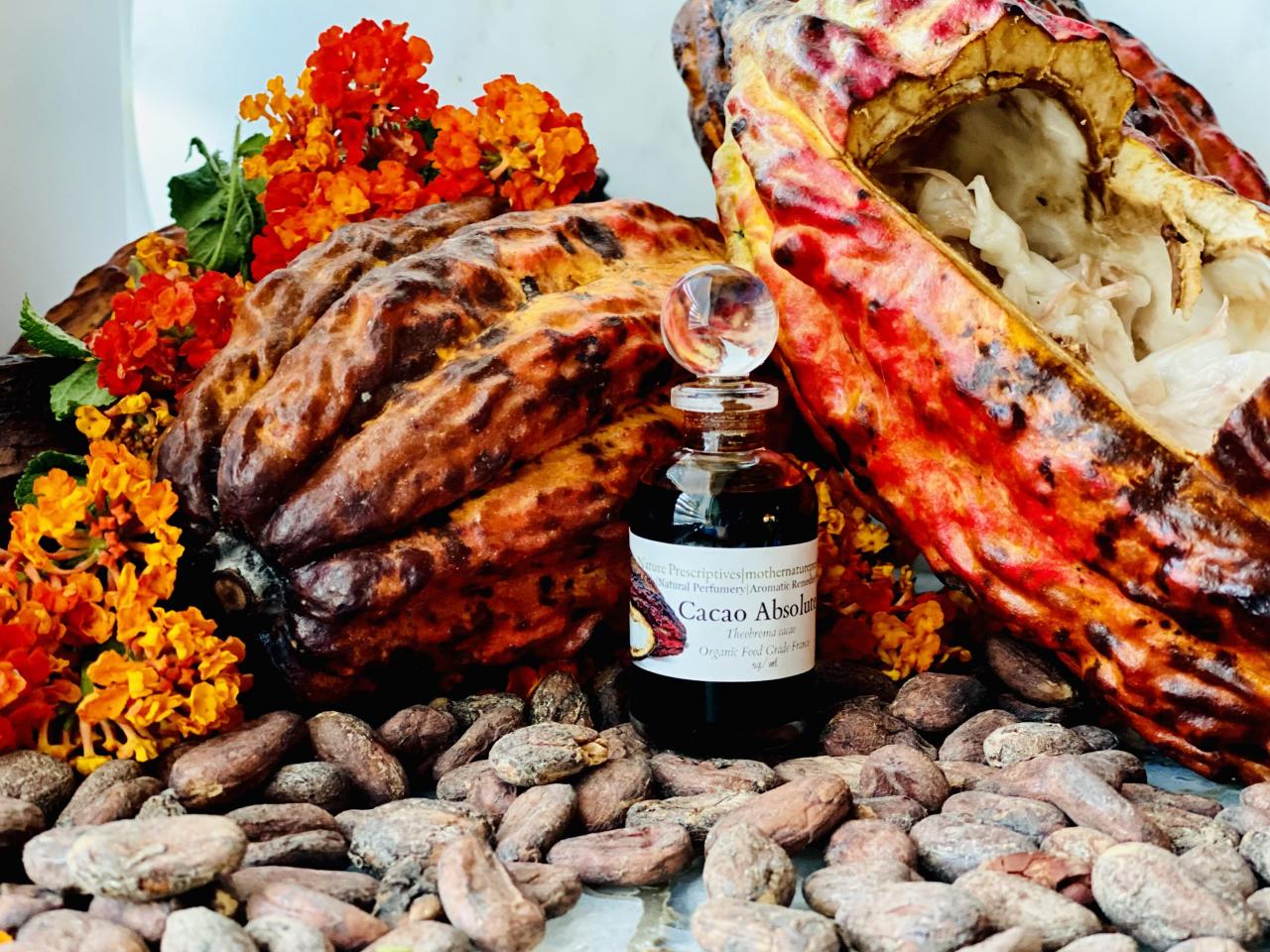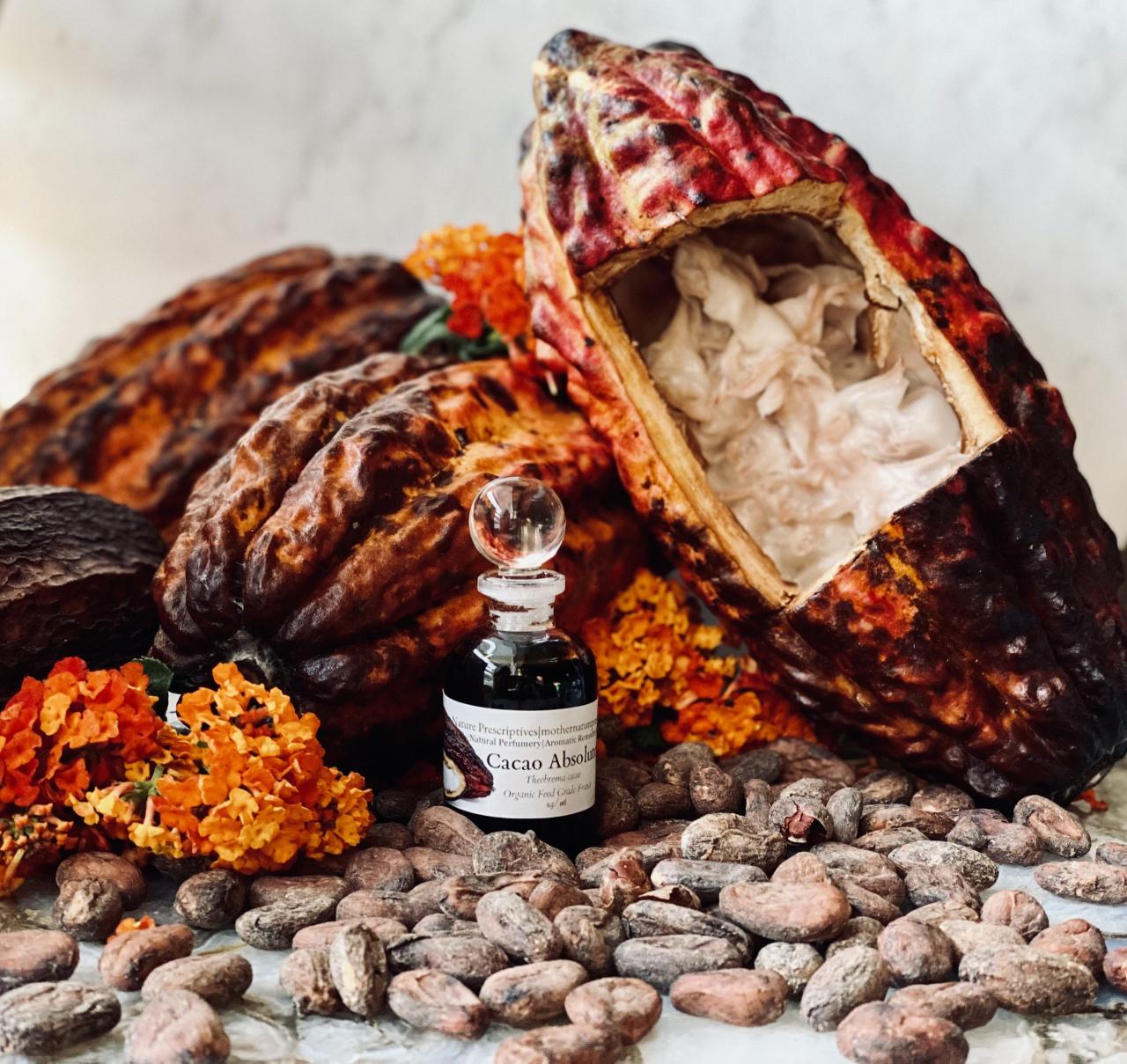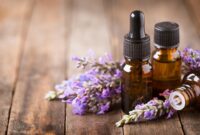Cocoa essential oil, derived from the cocoa plant, is a versatile and potent substance that offers a wide range of therapeutic, cosmetic, and culinary benefits. Its unique composition and captivating aroma make it a sought-after ingredient in various industries, promising to enhance well-being, beauty, and culinary experiences.
This essential oil boasts an impressive array of antioxidants and anti-inflammatory compounds, making it a powerful ally for promoting overall health and vitality. Its calming and relaxing effects also contribute to its popularity in aromatherapy, where it is used to alleviate stress, anxiety, and promote restful sleep.
Botanical Overview
The cocoa tree ( Theobroma cacao) is an evergreen tree native to the tropical regions of the Americas. It is cultivated for its seeds, which are used to produce cocoa powder, chocolate, and cocoa butter. Cocoa essential oil is extracted from the fermented and roasted seeds of the cocoa tree.
The extraction process of cocoa essential oil involves several steps. First, the cocoa beans are fermented and roasted to develop their characteristic flavor and aroma. The roasted beans are then ground into a paste, which is pressed to extract the cocoa butter.
The remaining cocoa solids are then subjected to steam distillation to extract the essential oil.
Chemical Composition
Cocoa essential oil is a complex mixture of over 300 chemical compounds. The major constituents of the oil are terpenes, esters, and alkaloids. The terpenes give cocoa essential oil its characteristic earthy, woody aroma. The esters contribute to the oil’s sweet, fruity notes.
The alkaloids, including theobromine and caffeine, give cocoa essential oil its stimulating and mood-boosting effects.
Therapeutic Properties: Cocoa Essential Oil
Cocoa essential oil possesses remarkable therapeutic properties, making it a valuable addition to natural remedies. Its antioxidant and anti-inflammatory capabilities, along with its ability to promote wound healing, contribute to its therapeutic benefits.
Antioxidant Properties
Cocoa essential oil is a rich source of antioxidants, including flavonoids and polyphenols. These compounds combat free radicals, which are unstable molecules that can damage cells and contribute to aging and chronic diseases. By neutralizing free radicals, cocoa essential oil protects the body against oxidative stress, reducing the risk of various health conditions.
Anti-inflammatory Effects
Cocoa essential oil exhibits potent anti-inflammatory properties. It contains theobromine, a compound known to inhibit the production of pro-inflammatory cytokines. By reducing inflammation, cocoa essential oil can alleviate pain, swelling, and discomfort associated with various conditions, including arthritis, muscle pain, and skin irritation.
Wound Healing
Cocoa essential oil has been shown to promote wound healing. Its antimicrobial properties help prevent infection, while its anti-inflammatory effects reduce swelling and pain. Additionally, cocoa essential oil stimulates collagen production, a protein essential for tissue repair and wound closure.
By promoting a favorable healing environment, cocoa essential oil can accelerate the healing process and reduce scarring.
Aromatherapy Applications
Cocoa essential oil, extracted from the cocoa bean, has gained prominence in aromatherapy due to its calming and relaxing effects. Its rich, chocolatey aroma creates a soothing and comforting atmosphere, making it an ideal choice for alleviating stress and anxiety.
Theobromine, a compound found in cocoa, is known for its mood-boosting properties. When inhaled, cocoa essential oil stimulates the release of endorphins, which have calming and stress-reducing effects. It can help reduce feelings of tension, anxiety, and restlessness, promoting a sense of tranquility and relaxation.
Methods of Use, Cocoa essential oil
Cocoa essential oil can be incorporated into aromatherapy practices in various ways:
- Diffusion: Add a few drops of cocoa essential oil to a diffuser and disperse it throughout a room to create a calming and relaxing atmosphere.
- Inhalation: Inhale the aroma of cocoa essential oil directly from the bottle or by placing a few drops on a tissue or cotton ball.
- Massage: Dilute cocoa essential oil with a carrier oil, such as jojoba or coconut oil, and massage it into the skin for a relaxing and soothing experience.
- Bath: Add a few drops of cocoa essential oil to a warm bath to create a luxurious and stress-relieving experience.
Cosmetic Applications

Cocoa essential oil has gained popularity in the cosmetic industry due to its moisturizing and skin-enhancing properties. Its rich composition of fatty acids and antioxidants makes it a valuable ingredient for various skincare products.
Moisturizing Properties
Cocoa essential oil is an excellent moisturizer for both dry and sensitive skin. Its high content of oleic acid and stearic acid helps to hydrate the skin deeply, leaving it soft and supple. The oil forms a protective layer on the skin’s surface, preventing moisture loss and protecting it from environmental stressors.
Skin Elasticity
Cocoa essential oil contains antioxidants such as flavonoids and polyphenols, which help to improve skin elasticity and reduce the appearance of wrinkles. These compounds stimulate collagen and elastin production, which are essential proteins for maintaining skin firmness and youthful appearance.
Cosmetic Products
Cocoa essential oil is commonly used in a variety of cosmetic products, including:
- Moisturizers and lotions
- Anti-aging creams
- Body butters
- Lip balms
- Hair conditioners
Culinary Applications

Cocoa essential oil possesses a unique and captivating aroma and flavor that make it a sought-after ingredient in culinary creations. Its rich, chocolatey notes impart a delectable depth to various dishes, ranging from desserts to savory creations.
Cocoa essential oil can be effectively utilized as a flavoring agent, adding a touch of chocolatey indulgence to baked goods, beverages, and even savory dishes. It seamlessly blends with other flavors, complementing sweet and savory ingredients alike.
In Desserts
- Enhance the richness of chocolate cakes, brownies, and truffles by adding a few drops of cocoa essential oil to the batter.
- Create a velvety chocolate mousse by incorporating cocoa essential oil into the whipped cream.
- Elevate the flavor of chocolate ice cream by adding a touch of cocoa essential oil during the churning process.
In Beverages
- Infuse hot chocolate with the decadent aroma of cocoa essential oil for a luxurious and comforting treat.
- Add a hint of chocolatey indulgence to coffee or tea by stirring in a drop or two of cocoa essential oil.
- Create a refreshing and flavorful iced cocoa by blending cocoa essential oil with almond milk or coconut milk.
In Savory Dishes
- Add a touch of chocolatey complexity to mole sauces and other Mexican dishes by incorporating cocoa essential oil.
- Enhance the flavor of roasted meats, such as lamb or duck, by rubbing them with a mixture of cocoa essential oil and spices.
- Create a unique and savory chocolate marinade for tofu or tempeh by combining cocoa essential oil with soy sauce and sesame oil.
Safety Considerations
Cocoa essential oil is generally safe for topical and aromatic use. However, as with any essential oil, it’s crucial to use it safely to avoid potential risks and side effects.
When using cocoa essential oil topically, it’s recommended to dilute it with a carrier oil, such as jojoba or almond oil, at a ratio of 2-3 drops of essential oil per 10ml of carrier oil. This helps prevent skin irritation or allergic reactions.
Pregnancy and Breastfeeding
Pregnant or breastfeeding women should consult a healthcare professional before using cocoa essential oil. The safety of cocoa essential oil during these periods has not been fully established, and it’s best to err on the side of caution.
Potential Risks and Side Effects
- Skin irritation:Undiluted cocoa essential oil may cause skin irritation or allergic reactions in some individuals. Always perform a patch test on a small area of skin before using it more widely.
- Photosensitivity:Cocoa essential oil may increase skin sensitivity to sunlight. Avoid applying it to skin that will be exposed to direct sunlight.
- Ingestion:Cocoa essential oil is not safe for ingestion. If swallowed, it may cause nausea, vomiting, or other adverse effects.
Conclusion

In summary, cocoa essential oil is a remarkable natural remedy with a plethora of benefits. Its therapeutic properties, cosmetic applications, and culinary versatility make it a valuable addition to any home. Whether used for relaxation, skincare, or culinary creations, cocoa essential oil has the power to elevate your well-being and enrich your life.
Essential FAQs
Is cocoa essential oil safe to ingest?
No, cocoa essential oil is not safe to ingest and should only be used topically or through inhalation.
Can cocoa essential oil be used on all skin types?
Cocoa essential oil is generally safe for most skin types, but it is always advisable to perform a patch test before applying it to a larger area.
How often can I use cocoa essential oil in my skincare routine?
Cocoa essential oil can be used daily in your skincare routine, but it is important to dilute it with a carrier oil, such as coconut or jojoba oil, before applying it to your skin.


